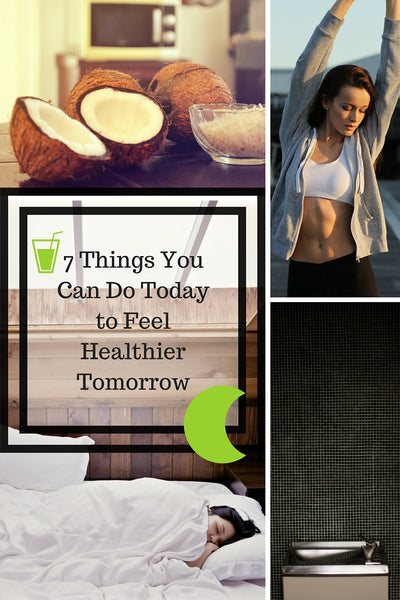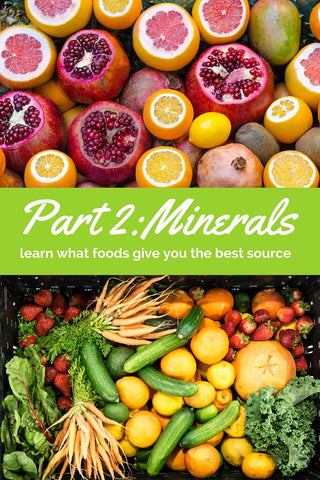Living Well — motivation
7 Things You Can Do Today to Feel Healthier Tomorrow 0
Sometimes you’re just in need of a quick way to help get you back on track with your health and wellness goals. Well here are 7 of them that you can do right now to start improving your wellness routine and get back into the habit of being health conscious.
Oil Pulling—oil what?! Let us explain by thinking of it this way—rather than using mouthwash we’re using oil, like coconut oil, and instead of 30 seconds, try 15-20 minutes. But the benefits look so promising, you’ll want to get started right away! First off, we love coconut oil because by itself it has vitamins A, B, D and K. View our other blog post here to see vitamin benefits for your body. At the very least, coconut oil is a great organic substitute for mouthwash and can help improve skin and teeth. So what else is going on while you’re swishing around coconut oil for 20 minutes? The idea is that the toxins are being ‘pulled’ out into your mouth, so you’ll definitely want to spit it out afterwards (be sure to spit in the trash so you don’t risk the oil clogging up your sink). Try taking 1 tablespoon per day—people have claimed seeing results after just one use, but we recommend trying it for a whole week to see what it can do for you!
Breathing Exercises—who knew something so simple could have so many benefits? When you take several deep breaths—breathing slowly all the way in and all the way out—it activates your vagus nerve (in laymen’s terms, your body switches from storing fat to burning it). In addition, the process of breathing in so deeply rids your lungs of carbon dioxide and as a result increase your oxygen intake. So what are you waiting for—get breathing!
Drink Water—you know the saying, drink water now, because you’ll need it later! Whether you’ve heard it or not, it’s very true. If you’re someone who rarely drinks a glass of water, we guarantee you’ll notice a huge difference in the way you feel when you drink 2 to 3 liters a day. Although studies show differing recommendations on how much water you should drink, we’ve found the easiest way to drink water is to always carry it on your person, and when in doubt, take a sip! Not only does it keep you hydrated, but it regulates your body temperature, cushions your joints, and helps rid your body of harmful toxins. Another easy way to tell you’re getting enough water—your urine is light yellow or colorless!
Daily Oil Dosage—yep, we’re talking about CBD Hemp Oil! It comes in several different forms you can check out here, but a daily dose of it can help take you from distress to de-stress. Ahhh.
Tongue Scraping—another great way to extract toxins and bacteria from your body is by purchasing these scrapers inexpensively at health food stores and pharmacies. Throughout the day, bacteria and plaque covers up our tongue, so it makes sense that it can be more difficult to taste our food. But the effect doesn’t stop there—it can make us overcompensate with salt and sugar, ending in a series of overeating. To get the best effect, buy an actual tongue scraper instead of just using your toothbrush to really get those toxins off so you can start tasting again!
Sweat and Stretch—and in this order! Yet another way to get to release toxins from your body is through sweat, so get out and get moving! Exercise should be a daily occurrence anyways, and you want to make sure that you stretch after your warm up and before you start your full-fledged routine—that way your muscles have time to warm up and will stretch better and reduce the risk of injury.
Go to Bed!—although all of these options are great for feeling better as soon as the next day, they’ll all be for nothing if you stay up until the wee hours of the morning. Even though it might be difficult at times, your body will truly thank you the next day if you can squeeze in 7-8 hours of sleep the night before. On top of feeling more energized, it will help keep you on track with healthier eating and your skin will look a lot healthier—how could you pass up on these benefits just from getting a little more shuteye?!
- Kate Hurd
- Tags: daily exercise goals health healthy living hemp hemp oil live well motivation natural nutrition organic relaxation wellness


 In part 1, we discussed the different vitamins and how to incorporate them into your diet by choosing the best food sources. This time around, we’re looking at the minerals out there and how you can maximize your intake by following our list of foods for each category. Did you miss Part 1: Vitamins? You can check it out right
In part 1, we discussed the different vitamins and how to incorporate them into your diet by choosing the best food sources. This time around, we’re looking at the minerals out there and how you can maximize your intake by following our list of foods for each category. Did you miss Part 1: Vitamins? You can check it out right  It’s common to hear that you should eat oranges if you need more vitamin C in your diet or have a banana if you want to get some potassium. What you may not realize is that there are other food sources with a much higher vitamin or mineral content you may be missing out on. Here we take a look at the top foods you should be eating to get the most bang for your buck to incorporate those essential vitamins and minerals into your daily diet. We’ve broken it down into two parts: vitamins and minerals. Let’s start with vitamins and be on the lookout for more on minerals later! In order to provide you with the ultimate best food choices, to make our list the food sources had to provide at least 50% of the dietary reference intake (per the USDA) in one serving. Take a look!
It’s common to hear that you should eat oranges if you need more vitamin C in your diet or have a banana if you want to get some potassium. What you may not realize is that there are other food sources with a much higher vitamin or mineral content you may be missing out on. Here we take a look at the top foods you should be eating to get the most bang for your buck to incorporate those essential vitamins and minerals into your daily diet. We’ve broken it down into two parts: vitamins and minerals. Let’s start with vitamins and be on the lookout for more on minerals later! In order to provide you with the ultimate best food choices, to make our list the food sources had to provide at least 50% of the dietary reference intake (per the USDA) in one serving. Take a look!